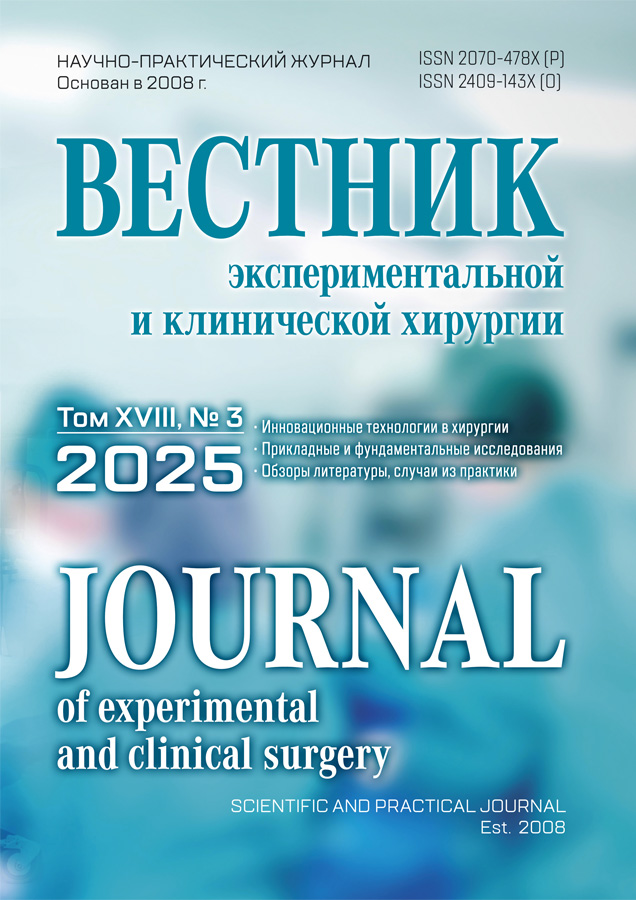Combined pancreatic solid-pseudo-papillary tumor and spleen lesions: diagnosis complexities in determining treatment tactics
- Authors: Stepanova Y.A.1, Ionkin D.A.1, Alimurzaeva M.Z.2, Arutyunov O.R.1, Markov P.V.1, Shirokov V.S.1, Spitsyna A.I.1, Glotov A.V.1
-
Affiliations:
- A.V. Vishnevsky National Medical Research Center of Surgery
- Dagestan State Medical University
- Issue: Vol 18, No 3 (2025)
- Pages: 195-207
- Section: Cases from practice
- URL: https://vestnik-surgery.com/journal/article/view/1872
- DOI: https://doi.org/10.18499/2070-478X-2025-18-3-195-207
- ID: 1872
Cite item
Abstract
Solid pseudopapillary tumors (SPTs) are rare neoplasms, which account for less than 2% of exocrine pancreatic tumors. These are low-grade epithelial malignancies. Currently, there are no data on SPT metastasis to the spleen in the literature. However, due to the rare SPT incidence and the ongoing accumulation and data analysis on these type of tumors globally, the presence of a combined cystic-solid structure lesion in the spleen does not allow us to exclude such a situation.
Two clinical cases of SPT combined with focal spleen lesions are presented. The first one is with a cystic lesion verified as cavernous spleen lymphangioma according to the morphology of the removed lesion. Despite the fact that the splenic lesions included in the differential series during examination were benign, the size of the lesion and the risk of its rupture demonstrated the advisability of spleen resection performing.
The second one is combined with multiple spleen hemangiomas verified by preoperative MSCT, which allowed performing a sparing operation - median resection (tumor enucleation) of the pancreatic head.
Thus, а thorough examination of patients with combined focal lesions, one of which being SPT, a tumor with malignant potential, allows us to clearly determine the entire volume of the lesion and determine the correct surgical tactics.
Full Text
About the authors
Yulia Alexandrovna Stepanova
A.V. Vishnevsky National Medical Research Center of Surgery
Author for correspondence.
Email: stepanovaua@mail.ru
M.D., Prof., Senior Researcher, Department of Ultrasound department
Russian Federation, MoscowDmitry Anatolevich Ionkin
A.V. Vishnevsky National Medical Research Center of Surgery
Email: da.ionkin@gmail.com
PhD, Associate Professor of the Educational Department, Surgeon of the Department of Abdominal Surgery
Russian Federation, MoscowMaksalina Zakaryaevna Alimurzaeva
Dagestan State Medical University
Email: maksalina1992@yandex.ru
assistant at Radiology Diagnostics and Radiation Therapy Department with a course in Ultrasound Diagnostics
Russian Federation, MakhachkalaOvanes Robertovich Arutyunov
A.V. Vishnevsky National Medical Research Center of Surgery
Email: arutyunov_ovanes@mail.ru
surgeon of Abdominal Surgery Department
Russian Federation, MoscowPavel Viktorovich Markov
A.V. Vishnevsky National Medical Research Center of Surgery
Email: pvmarkov@mail.ru
Doct. of Med. Scien., Head of Abdominal Surgery Department
Russian Federation, MoscowVadim Sergeevich Shirokov
A.V. Vishnevsky National Medical Research Center of Surgery
Email: vadimshirokov@yandex.ru
radiologist of Roentgenology and Magnetic Resonance Department
Russian Federation, MoscowAnastasia Igorevna Spitsyna
A.V. Vishnevsky National Medical Research Center of Surgery
Email: vostri2013@yandex.ru
1st year resident in the specialty «radiology»
Russian Federation, MoscowAndrey Vyacheslavovich Glotov
A.V. Vishnevsky National Medical Research Center of Surgery
Email: andrew.glotov@mail.ru
pathologist of pathological department
Russian Federation, MoscowReferences
- Frantz V.K. Tumors of the pancreas. Atlas of tumor pathology. VII. Fascicles 27 and 28. Washington: Armed Forced Institute of Pathology; 1959; 32–33.
- Kloppel G, Solcia E, Longnecker DS, Capella C, Sobin LH. World Health Organization. World Health Organization International histological classification of tumours. 2nd ed. Berlin. Springer. 1996; 8452/1.
- Klöppel G, Hruban RH, Klimstra DS, Bosman FT, Carneiro F, Hruban RH, Theise ND. Solid-pseudopapillary neoplasm. WHO Classification of Tumours of the Digestive System. Lyon: International Agency for Research on Cancer. 2010; 327–330.
- Ye JH, Ma MZ, Cheng DF, Yuan F, Deng X, Zhan Q, Shen B, Peng C. Solid-pseudopapillary tumor of the pancreas: clinical features, pathological characteristics, and origin. J Surg Oncol. 2012; 106: 728–735. doi: 10.1002/jso.23195.
- Kim MJ, Choi DW, Choi SH, Heo JS, Sung JY. Surgical treatment of solid pseudopapillary neoplasms of the pancreas and risk factors for malignancy. Br J Surg. 2014; 101: 1266–1271. doi: 10.1002/bjs.9577.
- Lee SE, Jang JY, Hwang DW, Park KW, Kim SW. Clinical features and outcome of solid pseudopapillary neoplasm: differences between adults and children. Arch Surg. 2008; 143: 1218–1221. doi: 10.1001/archsurg.143.12.1218.
- Huang HL, Shih SC, Chang WH, Wang TE, Chen MJ, Chan YJ. Solid-pseudopapillary tumor of the pancreas: Clinical experience and literature review. World J Gastroenterol. 2005; 11: 1403–1409. doi: 10.3748/wjg.v11.i9.1403.
- Uguz A, Unalp OV, Akpınar G, Karaca CA, Oruc N, Nart D, Yılmaz F, Aydın A, Coker A. Solid pseudopapillary neoplasms of the pancreas: Case series with a review of the literature. Turk J Gastroenterol. 2020; 31(12): 930-935. doi: 10.5152/tjg.2020.19227.
- Byron EC. Solid and papillary epithelial neoplasm of the pancreas, diagnosis by cytology. South Med. J. 1998; 91: 973–977.
- Papavramidis T, Papavramidis S. Solid pseudopapillary tumors of the pancreas: review of 718 patients reported in the English literature. J Am Coll Surg. 2005; 2: 965–972. doi: 10.1016/j.jamcollsurg.2005.02.011.
- McCluney S, Wijesuriya N, Sheshappanavar V, Chin-Aleong J, Feakins R, Hutchins R, Abraham A, Bhattacharya S, Valente R, Kocher H. Solid pseudopapillary tumour of the pancreas: clinicopathological analysis. ANZ J Surg. 2018; 88(9): 891-895. doi: 10.1111/ans.14362.
- Martin RC, Klimstra DS, Brennan MF, Conlon KC. Solid-pseudopapillary tumor of pancreas: a surgical enigma? Ann Surg Oncol. 2002; 9: 35–40. doi: 10.1245/aso.2002.9.1.35.
- Santini D, Poli F, Lega S. Solid-papillary tumors of the pancreas: histopatology. JOP. 2006; 7(1): 131-136.
- Liu Q, Dai M, Guo J, Wu H, Wang W, Chen G, Hu Y, Han X, Xu Q, Zhang X, Yang S, Zhang Y, Kleeff J, Liao Q, Wu W, Liang Z, Zhang T, Zhao Y. Long-term Survival, Quality of Life, and Molecular Features of the Patients With Solid Pseudopapillary Neoplasm of the Pancreas: A Retrospective Study of 454 Cases. Ann Surg. 2023; 278(6): 1009-1017. doi: 10.1097/SLA.0000000000005842.
- Volk M, Strotzer M. Diagnostic imaging of splenic disease. Radiologe. 2006; 46: 229–243. doi: 10.1007/s00117-005-1333-8
- Caremani M, Occhini U, Caremani A, Tacconi D, Lapini L, Accorsi A, Mazzarelli C. Focal splenic lesions: US findings. J Ultrasound. 2013; 16(2): 65-74. doi: 10.1007/s40477-013-0014-0.
- Barat M, Hoeffel C, Aissaoui M, Dohan A, Oudjit A, Dautry R, Paisant A, Malgras B, Cottereau AS, Soyer P. Focal splenic lesions: Imaging spectrum of diseases on CT, MRI and PET/CT. Diagn Interv Imaging. 2021; 102(9): 501-513. doi: 10.1016/j.diii.2021.03.006.
- Comperat E, Bardier-Dupas A, Camparo P, Capron F, Charlotte F. Splenic metastases: clinicopathologic presentation, differential diagnosis, and pathogenesis. Arch Pathol Lab Med. 2007; 131(6): 965-969. doi: 10.5858/2007-131-965-SMCPDD.
- Ionkin DA, Karmazanovsky GG, Stepanova YuA, Shurakova AB, Zhurenkova TV, Shchegolev AI, Dubova EA. Rare malignant lesions of the spleen: malignancy of epidermoid cyst and metastases to the spleen. Vestnik Natsional'nogo mediko-khirurgicheskogo Tsentra im. N.I. Pirogova. 2011; 6(4): 137-143.
- Sufficool K, Wang J, Doherty S. Isolated splenic metastasis from carcinoma of the breast: a case report. Diagn Cytopathol. 2013; 41: 914–916. doi: 10.1002/dc.22860
- Lee HJ, Kim JW, Hong JH, Kim GS, Shin SS, Heo SH, Lim HS, Hur YH, Seon HJ, Jeong YY. Cross-sectional Imaging of Splenic Lesions: RadioGraphics Fundamentals. Online Presentation. Radiographics. 2018; 38(2): 435-436. doi: 10.1148/rg.2018170119.
- Lam KY. Metastatic tumors to the spleen: A 25 year clinicopathologic study. Arch Pathol Lab Med. 2000; 124: 526–530. doi: 10.5858/2000-124-0526-MTTTS.
- Berge T. Splenic metastases Frequencies and patterns. Acta Pathol Microbiol Scand. 1974; 82: 499–506.
- Hajjar R, Plasse M, Vandenbroucke-Menu F, Schwenter F, Sebajang H. Giant splenic cyst and solid pseudopapillary tumour of the pancreas managed with distal pancreatectomy and splenectomy. Ann R Coll Surg Engl. 2020; 102(4): e1-e3. doi: 10.1308/rcsann.2020.0010.
- Paramasivam S, Murali M, Rajappa P. Obstructed ileocaecal tuberculosis with splenic tuberculosis and solid pseudopapillary tumour of tail of pancreas in an immunocompetent woman. BMJ Case Rep. 2020; 13(9): e235195. doi: 10.1136/bcr-2020-235195.
Supplementary files
























